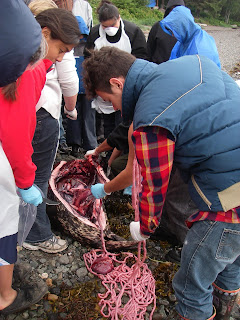


Saturday June 12th:
For the seal dissection we prepared by getting protective gear which included gloves and an aprin. Next we removed the head from the body. The next step was to make an incession along the anterior side of the seal. After that we removed all of the cardiovascular and digestive systems. Once they were removed we brought the seal down to the water's edge to rinse out the blood and bodily fluids. We then carried the seal back to the upper part of beach. We removed the ribs and spinal cord.Then we seperated the meat from the blubber and skinned the seal.Seal AdaptationsWe learned seals have whiskers for sensing things in the water. They use them to feel vibrations in the water so they know if anything is around them. They have blubber that keeps them warm and skin that sheds. They can't see in color but they have big eyes to see in the dark. They have claws to help them climb. Their ears are holes in their head instead of ear flaps. Their circulitory system has more blood than other animals and they are able to control where their blood goes and slow their beats down to seven beats per minute in order to go to deep depths.
No comments:
Post a Comment